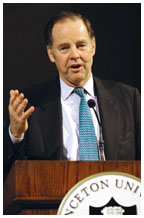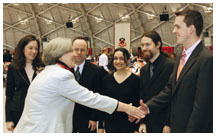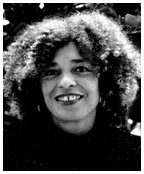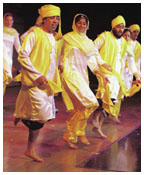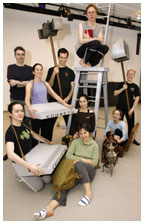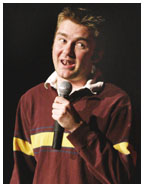Have an opinion about this issue of PAW? Please take a minute to click here and fill out our online questionnaire. It’s an easy way to let the editors know what you like and dislike, and how you think PAW might do better. (All responses will be kept anonymous.) |
March 23, 2005: Notebook
Alumni Day honors for Kean ’57, Myhrvold *83
Five win Princeton’s highest student accolades
Survey: Different views on race relations
Working to reform N.J. prisons
Reviving a ‘lost’ Prokofiev ballet
A talent show for the University
Alumni Day honors for Kean ’57, Myhrvold *83
Wilson Award winner Thomas Kean ’57, top photo, addresses an Alumni Day audience on America’s responses to terrorism. Above, Madison Medal honoree Nathan Myhrvold *83 discusses the “magic” of invention and its important economic role. (Photographs by Denise Applewhite) |
Former New Jersey Governor Thomas Kean ’57 entered Alexander Hall on Alumni Day, Feb. 26, with a muted sense of dread. “A shiver came over me when I came into this building,” he told the audience at a morning lecture as he motioned toward the vestibule and recalled his undergraduate days. “They posted the grades right out there.”
But after delivering his lecture on “Terrorism, 9/11, and the Future,” Kean, this year’s Woodrow Wilson Award winner and the chairman of the commission appointed to investigate the Sept. 11, 2001, terrorist attacks, added a new memory to his Alexander Hall experience: a standing ovation from a near full-house audience.
Kean and James Madison Medal honoree Nathan Myhrvold *83 joined about 1,200 alumni and family members for the annual winter celebration of Princeton that was first observed 90 years ago. Lectures, panel discussions, and receptions highlighted a daylong program of education and interaction.
Myhrvold, the former chief technology officer of Microsoft and founder of Microsoft Research, the company’s fundamental research division, opened the day with a presentation about “The Magic of Invention” at Alexander Hall. Inventing usually is a hobby for those who practice it, but Myhrvold argued that it can be a viable business in its own right, or at least an undertaking that corporations should support.
Myhrvold said that natural inspiration, such as the burrs that inspired George de Mestral to create Velcro, rarely leads to innovation. Instead, inventors are more successful when they take a systematic approach, as the Wright brothers did when they created a wind tunnel to study aerodynamics. Even “happy accidents” such as Teflon require someone to notice how the discovery might be applied, he said.
Alumni awards S. Barksdale Penick Jr. ’25 Award (for local Schools
Committee work) Class of 1926 Trophy (for raising the largest amount for
Annual Giving in a given year) Jerry Horton Award (for efforts to increase Annual Giving
amounts and participation) Harold H. Helm Award (for exemplary and sustained service
to Annual Giving) |
Computer technology, one of Myrhvold’s areas of expertise, has facilitated discovery. Computerized modeling and manufacturing, combined with greater connectivity and access to knowledge, could make the 21st century “an era of increasing and dynamic invention,” he said. With America’s role in manufacturing dwindling, he said, invention could become a key driver of economic growth, if companies foster it. “In much of life,” Myhrvold said, “form follows funding.” (After leaving Microsoft, Myhrvold created a company called Intellectual Ventures, which focuses on business issues related to the funding, creation, and commercialization of inventions.)
Kean spoke after Myhrvold, sharing his experiences with the 9/11 Commission and his hopes for the future of homeland security and international relations. He said public support helped the commission collect information and gain access to top officials, including President Bush, in spite of the tense partisan atmosphere of a presidential election year. Kean also credited the families of the 9/11 victims, who “channeled their personal anguish into a demand for the truth.”
Kean said the 9/11 Commission was careful to avoid the scapegoating that plagued the inquiry into Pearl Harbor and the unanswered questions that weakened the Warren Commission’s report on the assassination of President Kennedy. Kean also supported the intelligence reorganization passed by Congress in response to the 9/11 Commission’s recommendations, which called for the creation of a national intelligence director. “We’re safer today than we were a few years ago,” he said, “but we’re far from safe.”
Improving America’s security and its relations with the Arab world will require “more than military campaigns and metal detectors,” Kean said. He spoke specifically about encouraging governmental reform in Saudi Arabia and educational and economic growth in Afghanistan and Pakistan. He also stressed the need to take an interest in Arab culture. “We can’t expect to engage the Muslim world if we don’t understand the Muslim world,” he said. (Please see “A Moment With Thomas Kean ’57,” page 56.)
Other alumni programs included a morning panel that discussed careers in transition; an afternoon question-and-answer session with Dean of the College Nancy Weiss Malkiel and Vice President for Campus Life Janet Smith Dickerson; the annual Service of Remembrance, a memorial at the Chapel that honors Princetonians who died during the last year; and a dinner sponsored by the Association of Princeton Graduate Alumni. Undergraduate members of Princeton Engineering Education for Kids helped alumni children build mechanical toys with Lego blocks, and the Cotsen Children’s Library displayed its collection of Beatrix Potter materials.
At a luncheon in Jadwin Gym, President Tilghman presented the Moses Taylor Pyne Honor Prize, the University’s highest academic award for undergraduates, to Amy Saltzman ’05, an anthropology major from Gates Mills, Ohio. Tilghman also awarded Porter Ogden Jacobus Fellowships to graduate students Paul Copp, Holly Sanders, Scott Shell, and Lior Silberman. University trustee Robert Rawson ’66 handed out top honors to alumni for annual giving, community service, and schools committee work, and Tilghman returned to present the Madison and Wilson awards.
In accepting his honor, Kean reflected on the influence of his undergraduate
years. “As a teacher, as a legislator or a governor, as a college
president at Drew University, and certainly as chairman of the 9/11 Commission,”
Kean said, “in everything I have ever done in my life, Princeton
University has stayed with me and influenced me. And I think it always
will.” ![]()
By B.T.

Five win Princeton’s highest student accolades
President Tilghman offers congratulations to, from left, Pyne Prize winner Amy Saltzman ’05 and Jacobus Fellowship recipients Paul Copp, Holly Sanders, Lior Silberman, and Scott Shell. (Photo by Denise Applewhite) |
The Moses Taylor Pyne Honor Prize
Amy Saltzman ’05, anthropology
President Tilghman said, “By any measure, Amy has made the most
of her time at Princeton.” Active in the Undergraduate Student Government,
Outdoor Action, and other community service work, Saltzman has also excelled
as a scholar, both in molecular biology and in her concentration, anthropology.
Her senior thesis will analyze the postpartum and postnatal experiences
of ethnic Fijian women. Saltzman plans to attend medical school.
Porter
Ogden Jacobus Fellowships
Paul Copp, religion
Described by Professor Jacqueline Stone as “a fine scholar and an
astute, subtle thinker, with outstanding analytical skills,” Copp
has studied Chinese language and literature and spent time in a Buddhist
monastery for his research in Buddhist cultural history.
Holly Sanders, history
Sanders’ thesis examines the labor practices of prostitution in
postwar Japan; according to Professor Hendrik Hartog, she “has that
rare, justified confidence in her judgment that is ... the common mark
of all the really great historians I have known.”
Scott Shell, chemical engineering
With research aimed at understanding anomalous and supercooled liquids,
Shell’s “originality, creativity and maturity as a scientist
are extraordinary,” said Professor Pablo Debenedetti.
Lior Silberman, mathematics
Silberman’s thesis on the equadistribution of eigenfunctions on
higher-rank symmetric spaces, a problem in analytic number theory, is
“spectacular,” according to Professor Peter Sarnak, who said
Silberman is committed to relating mathematical abstractions to the real
world. ![]()

Survey: Different views on race relations
Princeton students from different racial and ethnic backgrounds have divergent views of race relations on campus, according to an Undergraduate Student Government survey on race and campus life
| Snapshots of race and campus life |
Asian
|
Black
students |
Hispanic
students |
White
students |
Other
students |
| Characterize
race relations on campus (on a scale of one to seven, where seven is “wonderful” and one is “extremely problematic”) |
3.97 | 3.60 | 3.78 | 4.30 | 4.10 |
|
Rate the faculty’s
support of your academic pursuits |
5.14 | 4.79 | 4.96 | 5.07 | 4.88 |
|
Rate
your social life on campus Source: USG Survey on Race and Campus Life Report |
4.23 | 3.71 | 4.16 | 4.82 | 3.99 |
Minority students make up about 28 percent of the undergraduate population at Princeton, a number that has remained relatively constant for a decade, but that diversity does not always translate into interaction between racial groups. About 75 percent of the students who took part in the survey said they socialize with the same small group of friends, and 43 percent of those students said their group of friends was racially homogeneous. Students split almost evenly when asked if their time at college had helped them to appreciate diversity: 51 percent said yes, 49 percent said no. President Tilghman said the findings were not unique to Princeton, but rather showed “a challenge that all colleges and universities face.”
More than half of the undergraduate student body responded to the survey, which covered general perceptions, academics, and social life and was released Feb. 14. When asked to rate diversity, race relations, and racial integration on campus, black and Hispanic students gave markedly lower ratings than white students. “That’s not necessarily new,” said USG president Leslie-Bernard Joseph ’06, “but I think seeing it in numbers should be useful for the community in general.”
The report did not make specific recommendations. The goal, former USG president Matt Margolin ’05 explained, was to use the data to explore solutions with student groups and administrators. (The complete Survey on Race and Campus Life Report is online at www. princeton.edu/usg/docs/racereport.pdf.)
Survey questions about academic issues could encourage a look at new programs, Joseph said, suggesting that the University consider a cultural studies distribution requirement. Only 60 percent of students have taken a course that focused on an area outside the United States or Western Europe. But much of the campus discussion of the survey focused on social life, particularly in the eating clubs. Minority students rated their social life on campus lower than white students did, and were less likely to join an eating club. Students from all racial groups expressed interest in social alternatives, away from “the Street.”
Janet Smith Dickerson, vice president for campus life, said current alternatives to the clubs take many forms, from dance parties at the Forbes Black Box Theater to late-night coffee and cookies in the basement café at Murray-Dodge Hall. But Joseph said a permanent venue, such as a nonalcoholic University-sponsored eating club, would give students a more reliable alternative. The four-year residential colleges may eventually fill that role; 20 percent of students said they were excited about the four-year residential college plan.
Former Inter-Club Council president J.W. Victor ’05 said the eating clubs have tried to reach out to a wider group of students through projects such as the Prospect Initiative, in which each club hosts one open, nonalcoholic party per semester, and Taste of Prospect, a dinner series that gives freshmen a taste of life in the clubs in the daylight hours. But those programs address only part of the problem, the survey showed, because the cost of membership is a factor for both minority and nonminority students who choose not to join. Students who receive University grants for meals cannot transfer those funds to an eating club. “Financial aid is the most important piece of the puzzle, and it’s also the most difficult,” said Victor, who proposes creating an endowment for eating club fees.
Changing the social scene may take time, but Joseph said students could start making a difference in race relations immediately by discussing the issues and encouraging more interaction. Dickerson agreed, adding that the conversation has value well beyond Princeton.
“As we move into a more diverse, more interconnected world,”
Dickerson said, “we need to have people who really have an understanding
of race, religion and faith, culture, and ethnicity.” ![]()
By B.T.

(Photo courtesy Angela Davis) |
“The assumption is that in order to do the most important work you must position yourself outside the institution of power. This is impossible: We inhabit it, we make it live. Once we recognize how we are implicated in it, we can disrupt it and we can encourage people to think critically about their part in it.”
Angela Davis, political activist and professor in the History of Consciousness
Program at the University of California, Santa Cruz, speaking Feb. 28
on “The Role of the Arts in Social Justice.” Davis is the
author of five books, including Angela Davis: An Autobiography and Women,
Race, and Class. ![]()

Working to reform N.J. prisons
A group of students is mounting a project to encourage a rethinking of New Jersey’s corrections policies, beginning with a lecture series in March and April on prison conditions and criminal sentencing.
About 20 students formed the Princeton Prison Project, which grew out of a visit to Trenton State Prison last spring by students of a class taught by politics lecturer Kiki Jamieson and precepted by William Potter ’68, a lawyer and adviser to the project.
“One of our major goals is to encourage the University, the community, and New Jersey legislators to open their eyes to the problems of biased and stringent sentencing in the criminal justice system,” said E. Spencer Compton ’05, project and conference co-coordinator. “I don’t think people realize the dramatic warehousing and overcrowding effect that our current policies have.”
The lecture series, called “An Unjust Sentence?” was to begin with a March 10 session in which four New Jersey prison inmates would discuss their “Stories from Behind the Bars.” The next program is scheduled for April 11 at 4:30 p.m. at McCosh 46, when Princeton faculty members Cornel West *80, Bruce Western *80, and Devah Pager, and Georgetown University law professor David Cole are to discuss racial discrimination in sentencing, incarceration, and re-entry to society.
Krista Brune ’06, co-coordinator of the effort, said students have met with the chairman of a state commission set up to review the fairness of New Jersey’s mandatory sentencing laws, and hope to meet with state legislators and combine forces with other organizations. Of particular concern, she said, is that New Jersey’s prison population has the largest racial disparity of any state in the nation: 63 percent of prisoners are black, while African-Americans make up only 14 percent of the state’s population. State Corrections Commissioner Devon Brown has described prisons as “America’s new plantation.”
The series is an offshoot of the Princeton Justice Project, a student
group created in 2001 to encourage independent research and community
collaboration to address issues of social injustice.![]()
By W.R.O.

Showing off
Building on the concept of “conspicuous consumption” coined
by sociologist Thorstein Veblen in the early 1900s, economics Ph.D. candidate
Ori Heffetz designed a survey to quantify the visibility of consumer purchases
and determine if people spend more on the things their peers notice most.
The survey found that consumers view groceries, utilities, and public
transportation expenditures as practically “non-visible,”
while dining out, clothing, and cars draw more attention. When Heffetz
compared the visibility results to data from a national survey of household
expenditures in a recent paper, he found the correlation between visibility
and spending was particularly strong for the top half of households ranked
by average income.
Artful dodgers
Americans today are less likely to watch ballet, take in a play, or listen
to live classical music than they were 20 years ago, and the drop has
been particularly sharp for college-educated audiences, sociology professor
Paul DiMaggio writes in a paper published last year in Poetics.
DiMaggio and Woodrow Wilson School researcher Toqir Mukhtar note, for
instance, that 33 percent of Americans with four or more years of higher
education attended a classical music performance in 1982. By 2002, the
rate had dropped to 26 percent. A crowded entertainment marketplace may
be partly to blame. “Given the proliferation of competitors for
the consumer’s entertainment dollar,” the authors say, “it
is surprising that public arts events have held up as well as they have.”
![]()

Photo by Frank Wojciechowski |
“CLAPPERS, CANES AND CATS: TRADITIONALLY PRINCETON” is the theme of a new exhibition at the Mudd Manuscript Library. The exhibition, which runs through July 15 in Weiss Lounge, offers material illustrating some well-known University customs, including dinks, Cane Spree, and stealing the clapper. It also includes numerous images of tigers and a model of the FitzRandolph Gate. Library hours are Monday to Friday, 9 a.m. to 4:45 p.m. and Wednesday evenings until 7:45.
Frances G. Beinecke, executive director of the NATURAL RESOURCES DEFENSE COUNCIL, will speak Tuesday, March 29, on “Opposing the Bush Onslaught: The Next Four Years of Environmental Advocacy.” The lecture, which is free, will begin at 4:30 p.m. in Bowl 016, Robertson Hall.
SANGAM, Princeton’s annual South Asian cultural show, will be held Thursday, March 31, at 8 p.m. in Richardson Auditorium. Performing will be student dance and theater groups from the University, including Naacho, right, and P-SAT, as well as Penn Masala, an a capella group. Admission is free for Princeton students; there will be a small charge for others.
ESSAYIST AND NOVELIST JOAN DIDION will speak on “Writing Politics” at a conference on Women, Art, and Politics in the 20th Century. The conference runs
April 1 from 11 a.m. through Didion’s keynote address at 5 p.m., and April 2 from 9 a.m. to 6 p.m. Conference speakers include cultural historian Morris Dickstein of the City University of New York and Irish poet Eavan Boland, a professor of English at Stanford University. All events will be held in the James Stewart Theater at 185 Nassau St. and are free and open to the public. For more information, go to www.princeton.edu/~prowom/current.html or call 609-258-5430. The conference is sponsored by the Women and Gender Studies Program, the University Lecture Series and the Fund for Irish Studies.
EFFORTS TO BATTLE THE GLOBAL SPREAD
OF AIDS will be discussed Tuesday, April 5, by Stephen
Morrison, director of the Africa Program and the Task Force on HIV/AIDS
for the Center for Strategic and International Studies. The topic of his
talk is “One Year-Plus into the President’s Emergency Program
for AIDS.” The talk is at 4 p.m. at 127 Corwin Hall.
![]()

Reviving a ‘lost’ Prokofiev ballet
Preparing for the Princeton performances of Prokofiev’s Le Pas d’Acier are, clockwise from lower left, Karima Nigmatulina ’05; assistant professor Simon Morrison *97; Mariah Steele ’06; Dusan Perovic ’05; Jed Peterson ’06, on top of ladder; Katherine Durlacher ’05; graduate student Johanna Frymoyer; Maria Ciocca ’05; and Alycia Somers ’04, sitting on ladder just above Ciocca. (Photo by Frank Wojciechowski) |
At Princeton next month, a 75-year-old Russian ballet will be performed for the first time as its noted composer intended, thanks to the quest of an assistant music professor and broad support from the University.
Le Pas d’Acier (The Steel Step) was conceived by Russian composer Sergei Prokofiev, composer of Peter and the Wolf and other 20th-century classics. The ballet was intended to present a celebratory vision of how industrialization was transforming mankind in the 1920s. But budget pressures and a change of choreographer led to significant changes when it debuted in Paris in 1927, causing a political scandal, and the ballet has not been performed for more than 50 years.
Simon Morrison *97, an assistant music professor who is a Prokofiev scholar, began raising funds in 2002 to bring the “lost ballet” back to life. With an investment of more than $175,000 from several University departments, the ballet will have what Morrison describes as “essentially a world premiere” at McCarter’s Berlind Theatre April 7—9.
The performance is very much a University production, Morrison said, with the University Orchestra performing the score for 30 student dancers. “Without the students’ own creativity, it wouldn’t happen,” he said. The $45,000 set, representing factory life, is being constructed by McCarter staff based on research and models prepared by theater historian Lesley-Anne Sayers.
Morrison described the 40-minute ballet as “a true synthesis of the arts,” bringing together music, dance, and stage decor in a way that was unprecedented in its time. “Literally, the set does come to life,” he said. “The factory parts look like humans, and the humans look like factory parts. The choreography is very acrobatic and very theatrical.”
At a time when the University is showing increased interest in promoting
the fine arts, Morrison said, the collaborative nature of this production
helped win the necessary support. “Seeing our orchestra and dance
programs come together has been truly marvelous,” he said. ![]()
By W.R.O.
For more information about the performance, go to www.pasdacier.com. Firestone Library is hosting a related exhibition at the Milberg Gallery for the Graphic Arts, titled “Pas d’Acier (The Steel Step): Re-Creation of a Lost Ballet,” that includes a model reconstruction of the ballet’s set and photographs of costumes from the original 1927 production. The exhibition runs through Sept. 25.

(Photo by Frank Wojciechowski) |
A talent show for the University
Tom Harrits ’05 performs a comedy routine as part of “This
Is Princeton,” a Feb. 17 showcase of University talent at Richardson
Auditorium with performances by faculty, staff, alumni, and students.
Harrits is a member of Quipfire! and a founding member of Princeton Stand-Up
comedy. The show raised nearly $3,000 for local youth arts scholarships
through Community House, a University-run community service program. ![]()
ON THE CAMPUS ONLINE: Click here to read more about “This Is Princeton” in Christian R. Burset ’07’s column, “Showing off; leaving ‘home.’”

Edmund Hull ’71, a decorated career State Department official, has been named the first diplomat-in-residence at the Woodrow Wilson School, helping to prepare students for diplomatic careers. Most recently Hull was ambassador to Yemen, after serving as the State Department’s acting coordinator for counterterrorism from 1999 to 2001. Hull’s responsibilities will include teaching, writing, giving public lectures, and meeting with students.
The University ranks eighth in the nation in recruiting National Merit Scholarship winners, with 192 among current freshmen. Harvard topped the list with 312, followed by the University of Florida with 259. Twenty-seven minority students recognized as National Achievement Scholars entered Princeton in the fall, compared to 85 at Harvard and 61 at Yale.
Peter Sarnak, the Eugene Higgins Professor of Mathematics at the University, has been awarded one of the highest honors in his field, the American Mathematical Society’s Frank Nelson Cole Prize in Number Theory. The award, which is given every three years, carries a $5,000 prize. The society cited Sarnak for his “fundamental contributions to number theory,” including his book Random Matrices: Frobenius Eigenvalues and Monodromy, which he wrote with Nicholas Katz *66, professor of mathematics.
The National Academy of Sciences has selected Princeton professor of chemistry Robert Cava to receive the 2005 John Carty Award for the Advancement of Science. The award, which includes a medal and a prize of $25,000, was given to Cava for his research into new materials with significant superconducting, dielectric, magnetic, or thermal properties. Cava chairs the Department of Chemistry.
Elias Stein, the Albert Baldwin Dod professor of mathematics, has received
the American Mathematical Society’s 2005 Stefan Bergman Prize for
“decisive contributions through his research, his expository efforts,
and his training of graduate students.” The honor includes a $17,000
prize. Stein previously won the Wolf Prize, one of the highest awards
in mathematics. Stein joined the faculty in 1963; in 2001 he received
the President’s Award for Distinguished Teaching. ![]()

FREDERICK WADE MOTE, professor of East Asian studies emeritus, died Feb. 10 in Colorado. He was 82. A scholar of Chinese civilization, Mote taught at Princeton from 1956 to 1987 and played a major role in the development of the East Asian studies department.
GEORGE A. GRAHAM,
a former chairman of the politics department, died in North Carolina Feb.
25 at the age of 100. Graham, who studied public administration and morality
in politics, was a member of the Princeton faculty from 1930 to 1958.
![]()


